
Torkilstrup Church is located in the village of Torkilstrup some 7 km (4 mi) southeast of Nørre Alslev, on the Danish island of Falster. It is built of hewn fieldstone rather than brick, indicating it is one of the oldest churches on the island from before 1160.

Eskilstrup Church is a church in Eskilstrup, Denmark. The church dates from the 12th century and was built in the Romanesque style. In accordance with a local tradition, it is painted red. It is best known for its frescos, said to be Denmark's oldest.

Knuthenborg is a manor house located 6 km (3.7 mi) north of Maribo on the Danish island of Lolland. Originally known as Årsmarke, it was first mentioned in 1372. Today's building was completed in 1866 to a design by Henrik Steffens Sibbern. The medieval manor of Årsmarke, with its more than 300 years of history, was once Denmark's largest private estate; it is now part of Knuthenborg Safaripark. The exotic shrubs and trees planted during the era of the Counts of Knuthenborg are situated on the grounds.

Toreby Church is the parish church of Toreby on the Danish island of Lolland. It is an unusually large red-brick Romanesque building, the nave and chancel having been extended in the Gothic period with a sacristy and lateral aisle. The tower is late Romanesque. There are frescos from c. 1400 in the sacristy. The carved pulpit (1645) is the work of Jørgen Ringnis.

Østofte Church, located in the village of Nørreballe on the Danish island of Lolland, was built in the 14th century. The Romanesque apse, chancel and nave formed the original building while the tower and porch were added in the Late-Gothic period and the north wing was completed in 1656.
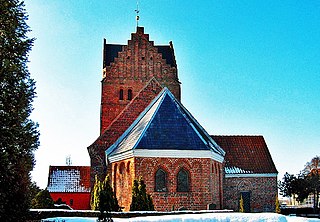
Stokkemarke Church is located in the village of Stokkemarke some 11 km (6.8 mi) northwest of Maribo on the Danish island of Lolland. Dating from the middle of the 13th century it was built in the Romanesque style with later additions in the Gothic period.
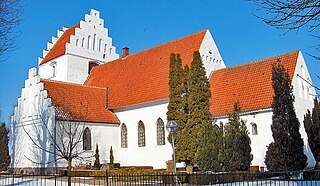
Hunseby is a village located some 3 km (1.9 mi) north of Maribo on the Danish island of Lolland. It belongs to Lolland Municipality in Region Sjælland. As of 2023, it has a population of 384.

Sandby Church is located in the village of Sandby some 7 km northwest of Nakskov on the Danish island of Lolland. Dating from the middle of the 13th century, the church has a Romanesque chancel and nave and a Late Gothic tower.
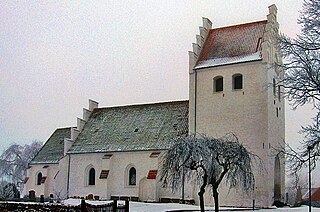
Errindlev Church is located in the village of Errindlev some 8 km northwest of Rødby on the Danish island of Lolland. Dating from the second half of the 12th century, the church has a Romanesque chancel and nave.

Halsted Church stands in the little village of Halsted some 6 km east of Nakskov on the Danish island of Lolland. Dating from the second half of the 12th century, the church has a Romanesque chancel and nave, a large burial chapel from 1636 and a tower from 1877. The church was closely associated with Halsted Priory, which has not survived.

Nakskov Church is the largest church in Nakskov on the west coast of the Danish island of Lolland. As Nakskov was mentioned in Valdemar's Census Book in the 13th century, the church probably dates to the same period.

Birket Church is located south of the little village of Birket, some 14 km (8.7 mi) northeast of Nakskov on the Danish island of Lolland. Its chancel was originally the nave of the brick Gothic church built in 1350. The bell tower, which stands apart from the church, is believed to be Denmark's oldest standing wooden structure.

Fuglse Church is a parish church located some 13 km (8.1 mi) south of Maribo on the Danish island of Lolland. The original Romanesque church was almost totally rebuilt in the Renaissance style in the late 16th century. Standing prominently on a hilltop, the red-plastered building has a tall spire roofed in shingles.
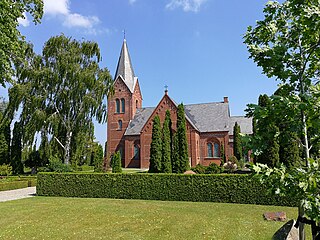
Bandholm Church is a Church of Denmark parish church located in the harbor village of Bandholm some 8 km (5.0 mi) north of Maribo on the Danish island of Lolland. It was built in 1874 by Henrik Steffens Sibbern to a cruciform plan in the Romanesque Revival style. Built of red brick, it consists of a chancel, a nave and a tower with a conical spire.
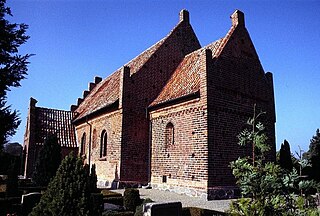
Olstrup Church is a Romanesque church in open country west of Errindlev in the south of the Danish island of Lolland. There are 16th-century frescos of the Last Judgment on the chancel arch with Christ sitting on a rainbow.

Dannemare Church is a Neo-Romanesque church in the village of Dannemare, some 12 km (7.5 mi) south of Nakskov on the Danish island of Lolland. Built in 1897, it replaced the earlier Romanesque church which burnt down in 1897.

Tillitse Church is a Romanesque building west of the village of Dannemare, some 8 km (5.0 mi) south of Nakskov on the Danish island of Lolland. Built of red brick in the first half of the 13th century, it has an intricately carved auricular altarpiece created by Jørgen Ringnis in 1642. An 11th-century runestone stands outside the church entrance.
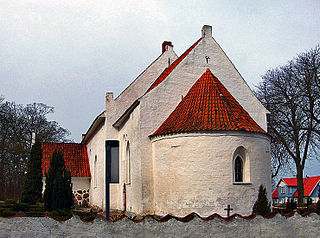
Arninge Church is a Late Romanesque church in the little village of Arninge, some 8 km (5.0 mi) south of Nakskov on the Danish island of Lolland. Built of red brick in the 13th century, it has an intricately carved auricular altarpiece created by Henrik Werner in 1644.

Gloslunde Church is a Romanesque church east of Dannemare, some 13 km (8.1 mi) southeast of Nakskov on the Danish island of Lolland. Now whitewashed, it was built of red brick in the 13th century. The heritage listed Gloslunde Rectory is located next to the church.
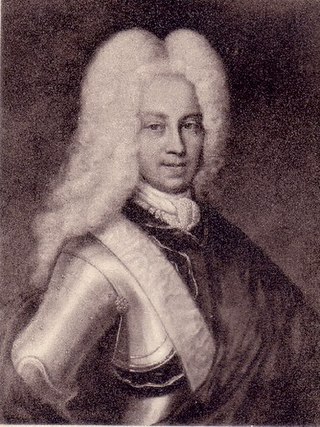
Adam Christopher (von) Knuth was the first Count of Knuthenborg. He established the manor of Knuthenlund. He was married twice, first to Hedevig Ulrikke Luxdorph and second time to Ida Margrethe von Reventlow.





















